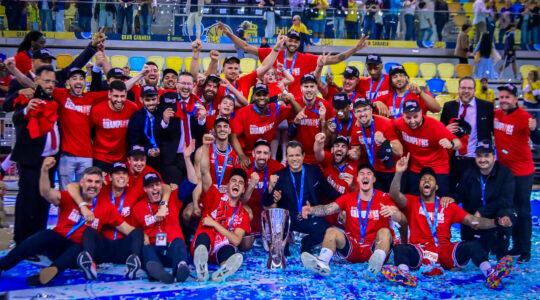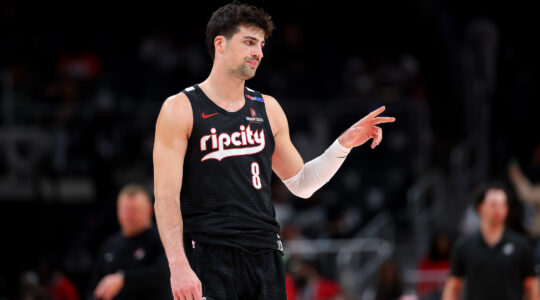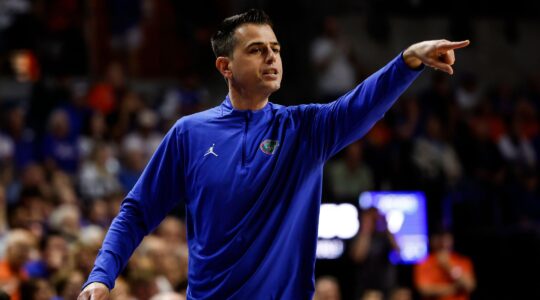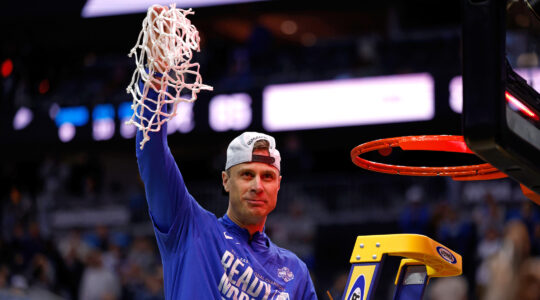
Baltimore Orioles manager Buck Showalter presenting Omri Amrany’s sculpture of a broken bat as a retirement gift to New York Yankees pitcher Mariano Rivera, Sept. 12, 2013. (Todd Olszewski/Courtesy of the Baltimore Orioles)
BALTIMORE (JTA) – Needing a gift for retiring New York Yankees reliever Mariano Rivera, the Baltimore Orioles pitched their idea for a sculpture to the Israel-born artist Omri Amrany.
No surprise there, even though Amrany knows nothing about baseball. The 59-year-old Amrany, now living in the Chicago area, has become the go-to guy for sculptures of athletic giants.
A week after the Orioles put in their request, they had their gift for Rivera, who retired Sunday after a record-breaking career with the Yanks.
The work was presented to Rivera during an on-field ceremony on Sept. 12 by Orioles manager Buck Showalter, who coincidentally was the pitcher’s first skipper in 1995 with the Yankees. It depicts a broken bat – the symbol of what often results when Rivera’s signature pitch, the cut fastball, bends toward hitters.
“We’ve been admirers of his work, especially in sports,” Greg Bader, the Orioles vice president for communications and marketing, said of Amrany. “We’re thrilled with how it turned out, and we think that Mariano was impressed, as well.”
Rivera joins a pantheon of all-time greats to be immortalized by Amrany. The group includes hockey legends Gordie Howe and Bobby Hull; Green Bay Packers football coaches Curly Lambeau and Vince Lombardi; Washington Senators pitcher Walter Johnson; Negro Leagues catcher Josh Gibson; Los Angeles Lakers basketball stars Kareem Abdul-Jabbar, Jerry West and Magic Johnson. Not to mention perhaps the greatest of them all, Michael Jordan of the Chicago Bulls.
Typically the statues are commissioned by the teams to adorn their arenas or, in Green Bay’s case, for a heritage campaign on sidewalks across the Wisconsin city.
Baseballs, footballs and hockey pucks were foreign to Amrany, who was raised on Kibbutz Ashdot Yaakov (Meuchad), just south of the Sea of Galilee, playing soccer. Among his jobs there, he worked in the banana orchards, date plantations and cotton fields. He also founded a musical club in its bomb shelter, which he painted in psychedelic colors. In another shelter he set up his art studio.
“If you’d have told me then I’d be an American citizen sculpting their famous sportsmen, I’d have told you you were nuts,” Amrany said.
A year later, though, after saying he wanted to be an artist, the kibbutz sent Amrany to Pietrasanta, Italy, to study marble carving. There he met Chicago native Julie Rotblatt, a fellow sculptor who in 1987 became his wife.

Omri Amrany’s sculpture of a broken bat was presented as a retirement gift to N.Y. Yankees pitcher Mariano Rivera on Sept. 12.
The Amranys and their son, Itamar, 24, now have a studio in Highwood, Ill., along with a stable of artists with whom they collaborate.
Amrany draws, paints and works in tapestry, and his sculptures use metal or stone. His subjects are diverse: soldiers, leaves, a bird, a dancer, a child in a wheelchair, police officers, a mother with her son. Clients include hospitals, corporations, municipalities and universities — and many sports teams.
His first break in the athletics realm occurred in 1994, when he and his wife won an artistic competition to design a monument to the immensely popular Jordan. The sculpture of the Bulls guard taking flight to a dunk opened the sports world’s eyes to Amrany “like 100 other pieces would not do,” he said.
“The guy who sculpted the Iwo Jima statue or Mount Rushmore — the size and the subject created their legacy,” Amrany said. Jordan represented “an opportunity of a lifetime to create a legacy piece.”
The bronze and stainless steel work necessitated more than four hours of meetings with Jordan, including a session in Nashville, Tenn., during Jordan’s temporary retirement from basketball to dabble in minor league baseball. Amrany said he measured “every piece of [Jordan’s] skin” and took 150 photographs of him, then set to work designing and sculpting the statue, which stands outside the Bulls’ arena.
But the sports floodgates truly opened in 1998, when the Amranys sculpted the statue of the Chicago Cubs’ beloved broadcaster Harry Caray that’s now outside Wrigley Field.
Soon after, Amrany received a telephone call from a woman whom he assumed worked for Detroit’s zoo because she asked if he could sculpt five tigers. Not imagining one facility’s containing so many of the creature, Amrany mentioned the conversation to another artist, who he said responded: “What are you, crazy? It’s the Detroit Tigers!”
And so it happened that Amrany sculpted the baseball team’s icons: Hank Greenberg, Ty Cobb, Hal Newhouser, Al Kaline and Charlie Gehringer.
For Rivera’s gift, Amrany wasn’t portraying a person, and he also faced a time crunch. The Orioles contacted him just over a week before the Yankees’ final visit to Baltimore prior to Rivera’s retirement, so what normally may have been spaced over several months was done “at the last minute,” Amrany explained.
Beauty being in the eye of the beholder, though, not everyone is enamored with Amrany’s work. His style tends toward what the artist called “expressionistic,” with a sense of an athlete’s motion, and Johnson’s grandson, Henry Thomas, told The New York Times last year that he abhorred the great pitcher being shown whipping a fastball with multiple right arms.
That’s OK with Amrany, who said he respects that Thomas “didn’t like this piece of art.”
“After all, art without criticism is something that is very boring,” Amrany said.
While the Rivera piece is the last Amrany project to be unveiled this baseball season, the artist has plenty more in the pipeline. He’s toiling on projects for teams in the minor leagues and for towns wanting to honor residents who went on to achieve great things as athletes. And he’s bidding on several commissions for New York teams.
All of which, Amrany says, aren’t turning him into a bigger baseball or even sports fan, but do increase his appreciation for the artistic side of an athlete’s craft.
“The human spirit of achievement, for me, is important. You can call it sport or anything you want,” he said. “In a way, it’s like the old history of Greek sport: looking at the clear achievement of the human personality.”
JTA has documented Jewish history in real-time for over a century. Keep our journalism strong by joining us in supporting independent, award-winning reporting.




